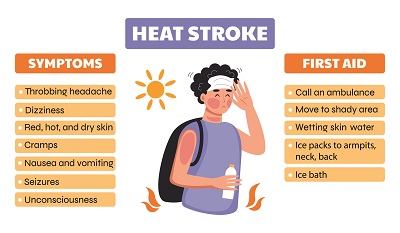By: Koena Mokobocho
Lesotho has been experiencing extremely hot weather conditions recently, accompanied by violent thunderstorms that have been known to cause extensive damage to power lines and houses. It is difficult to ignore the destruction caused by this kind of weather; the infrastructure damage and the adverse effects it has had on crops and crop yield. However, we also need to pay attention to the various risks that extreme heat poses to human health. Spending prolonged periods in the heat can lead to heat-related illnesses such as heatstroke (which can be life-threatening if not treated promptly) and heat exhaustion.
Heatstroke often occurs when your body is overheating; a drastic and dangerous rise in the normal body temperature typically above 40 degrees Celsius. The temperature rise is normally caused by prolonged heat exposure, especially when combined with dehydration and environments that lack cooling mechanisms. At this point – the overheating can be life-threatening as the body is no longer able to maintain a healthy temperature. It is necessary to treat heatstroke promptly to avoid damage to organs such as your brain, heart, kidneys, and muscles. The damage worsens the longer treatment is delayed.
The most identifiable heat stroke symptom is elevated body temperature. Other symptoms include; An altered mental state or behavior – confusion and agitation that is accompanied by slurred speech or even a coma can occur; the skin may feel dry to the touch due to dehydration or it may be wet due to profuse sweating; as the body tries to cope with the heat nausea and vomiting may occur and the skin may appear flushed due to the dilated blood vessels near the surface of the skin. The symptoms may differ in occurrence and intensity from person to person but can still pose a serious threat.
In a Facebook post, Lifesavers & First Aid Training mentioned that high temperatures have increased the likelihood of heatstroke and shared methods for preventing heatstroke. The overarching theme of the post was to stay cool and hydrated, Lifesavers & First Aid Training advised the public to soak towels in cold water and apply them to the skin, focusing on the armpit and neck regions; drink as much water as possible; use a fan if you have one or use a water spray bottle to cool yourself down.
As stated before, a heat stroke can be life-threatening, so it is paramount that one seeks medical assistance if someone has a heatstroke. While awaiting medical services, the person experiencing the heat stroke can be moved to a cooler environment to curb overheating, and excess clothing can be removed alongside other methods to try and cool the person down.
We need to stay cool in this extreme heat and stay cautious of the adverse effects it may have on our health. Educating ourselves on the subject matter improves our chances of preventing heat-related illnesses and avoiding preventable deaths.


